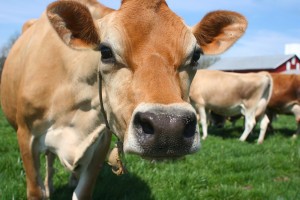I remember years ago when I was taking a drive to Anza Borrego with my Australian shepherd and drove past a large herd of cows.
I pulled over and, with several barks and yips out the window, my Aussie had all those scattered cows crowding at the fence looking at her. It was as if they were saying, “Ok, you got us here…now what?”
My little city dog gleefully wagged her stubby tail not realizing her open ended barks needed some more commands. I waved goodbye to the cows staring sweetly back at us, their curious and obedient natures a beautiful sight amongst the grassy fields and oak trees.
These days, seeing a cow would be an incredible sight since many fields just miles outside the city previously left for grazing have been trodden down with bull-dozers and civilization cemented in securely with casinos, shopping centers and homes.
That fact that factory farms have generously offered their mass marketing to consumers has left us with no choice but to get milk off a grocery shelf trucked in from many miles away. This requires heavy pasteurization to survive the long hauls.
People accept pasteurized milk to be perfectly fine and healthy and an excellent way to build strong bones. And though I have been a strong believer in mineralizing our bodies, bones and all, through deep green leafy vegetables and other non-dairy foods, I do believe milk has its place in our food consumption.
But the heavy pasteurization process kills everything in the milk, leaving a liquid protein that needs its nutrients added back to it, such as vitamin A, C, B6 and B12, all of which are greatly diminished when heated to such extremes.
Pasteurization process also leaves valuable enzymes destroyed, proteins shifted to unnatural amino acid configurations and the eradication of good bacteria.
Pasteurized milk is really not very good for anyone, even baby cows. Yet raw milk is highly nutritious. Leaving in all the nutrients in the milk by not pasteurizing increases the benefits tremendously, making it a healthy alternative to the extreme heat processing of pasteurized milk.
There is scare mongering from factory farms that state raw milk is not safe. But the fact is no food is 100 percent safe.
According to Claravale Farms, a family-owned dairy farm licensed by the State of California to produce raw milk, “Raw milk is no more or less dangerous than other processed foods.” They go on to say, “The potential pathogens that may occur in raw milk are the same as those which can occur on other foods such as produce, meat, fish, and pasteurized and processed dairy products.”
I’ve watched many items in my refrigerator decay, including pasteurized milk. The decay might take much longer than raw allowing the milk to keep, but the cost is less nutrition. I’d rather keep the nutrition in my milk by purchasing smaller quantities more frequently of the raw variety.
Raw milk is a very perishable food and is best consumed within the first week, but will last two. You will notice that in markets that sell raw milk, they do so in glass quart bottles. Glass keeps the flavor in and won’t alter the taste of the milk. Believe me, once raw milk is tasted, the “other” milk won’t stand a chance.
And don’t be fooled into looking for “grass fed” milk. Milk cows have different energy requirements than beef cattle, and the natural cycle is to eat highly nutritious hay which is dried grass in condensed form and grain which is dried seeds at certain times of the year. Cows don’t like a diet of just green pastures. Besides, grass fed cows produce milk that has an “off” flavor and does not taste as good.
If price becomes an issue, think about all the money spent on prescription and over-the-counter medications sitting in your cabinet.
I suggest reading “The Raw Truth About Milk” by William Campbell Douglas, M.D. for more information.
Contact Gina at [email protected].





